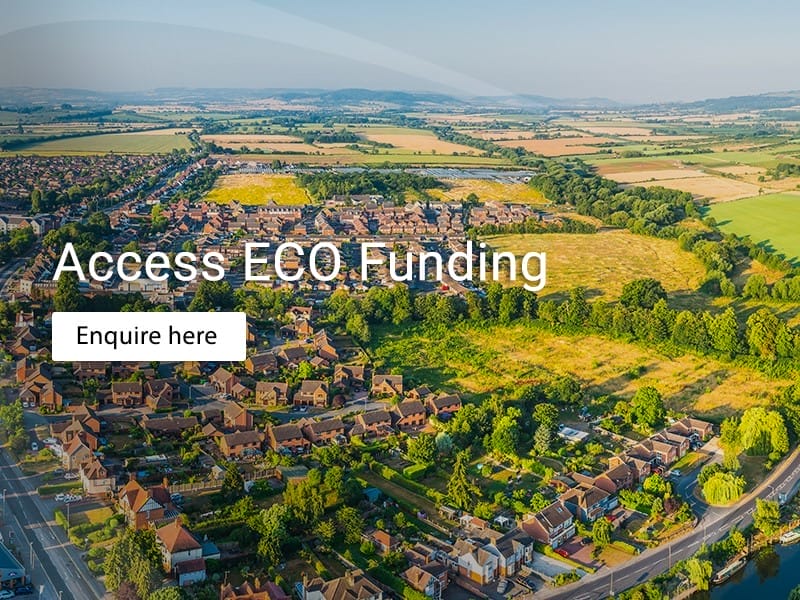The government Energy Company Obligation (ECO) is a scheme running across Great Britain to help lift households out of fuel poverty, whilst reducing carbon emissions.
As a managing agent for the scheme Anesco has funding available to facilitate energy efficiency upgrades to domestic dwellings.
We work closely with:
- PAS2030:2035 installers
- Local authorities
- Housing associations
- Private landlords
Funding is also available to low-income households that are deemed in fuel poverty. To qualify for funding the tenure, age and EPC rating of the property is assessed, and if a member of the household is in receipt of any government benefits.
As a tenant living in a private domestic property, either owner occupied or privately rented, funding is available through the Help to Heat Group if you are in receipt of a qualifying benefit such as:
- Income Based Jobseekers Allowance (JSA)
- Income related Employment and Support Allowance (ESA)
- Income Support (IS)
- Pension Credit Guarantee Credit (PCGC)
- Working Tax Credit (WTC)
- Child Tax Credit (CTC)
- Universal Credit (UC)
- Housing Benefit
- Pension Credit Savings Credit (PCSC)
- Child Benefit (subject to income caps and composition
ECO Flex – If the local authority deems the occupier of the property to be in fuel poverty, or on a low income and vulnerable to the cold, funding can be made available.
Infill – Occupiers of the properties adjacent to a prperty occupied by a household in receipt of a qualifying benefit may be eligible for ECO funding.
Cavity Wall Insulation
Owner occupied – EPC* rating D, E, F, G
Privately rented: EPC* rating E, F, G
Project must include an additional measure
Social housing: EPC* rating E,F,G
Solid Wall Insulation
Owner occupied – EPC* rating D, E, F, G
Privately rented: EPC* rating E,F,G
Social housing: EPC* rating E,F,G
Loft Insulation
Owner occupied – EPC* rating D, E, F, G
Privately rented: EPC* rating E, F, G
Project must include an additional measure
Social housing: EPC* rating E,F,G
Room in Roof Insulation
Owner occupied – EPC* rating D, E, F, G
Privately rented: EPC* rating E, F, G
Project must include an additional measure
Social housing: EPC* rating E,F,G
Underfloor Insulation (UFI)
Owner occupied – EPC* rating D, E, F, G
Privately rented: EPC* rating E, F, G
Project must include an additional measure
Social housing: EPC* rating E,F,G
Flat Roof Insulation
Change ECO3 to ECO4 – “Under ECO3 the option to install flat roof insulation is only available for habitable areas.”
Owner occupied – EPC* rating D, E, F, G
Privately rented: EPC* rating E, F, G
Project must include an additional measure
Social housing: EPC* rating E,F,G
Measures
The following provides an overview to the measures available under the ECO scheme along with details of eligibility.
Cavity Wall Insulation
To insulate a cavity wall, an Anesco ECO approved installer will drill small holes into the outside of the property. Insulation material is then injected into the cavity through the holes, which are then sealed. The insulation material used is usually either mineral wool, polystyrene bead or polyurethane foam.
The benefits of cavity wall insulation is a warmer home, reduced energy bills and a better carbon footprint.
Does your home have cavity walls?
The age of a property is the best way to determine how the walls were constructed. Properties built after the 1920s started to be built using cavity walls. If you still are unsure how old the property is, then the exposed brick can be used to identify the wall type. A cavity wall will typically have an even pattern of bricks of the same size.
How do you check if the cavity walls are already insulated?
Generally, properties built from 1990’s onward will have some insulation in the cavity. To make sure a qualified installer will drill a small hole in the wall and use a borescope to look inside the wall.
Properties without cavity walls have solid walls and need to be insulated differently. Hyperlink to solid wall section
Under the current ECO scheme, qualifying properties may be able to receive free cavity wall insulation. Eligible tenures for ECO Funding for Cavity Wall Insulation are:
- Owner occupied
- Privately rented: EPC* rating A,B,C,D,E
- Social housing: EPC* rating E,F,G
*Energy Performance Certificate
Solid Wall Insulation
The good news is that as with cavity walls, ECO funding for solid walls is available for qualifying properties.
How can you tell if you have solid walls?
One of the easiest ways to determine if a property has solid walls is to know when it was originally built. Properties built before 1944 typically have solid walls. If you are still unsure of the age of the property then the exposed bricks can be used to identify the wall type. In solid brick walls the bricks will have an alternating pattern, with some bricks laid across the wall with the short end visible.
The options for insulating solid wall properties are either with Internal Wall Insulation (IWI) or External Wall Insulation (EWI). Both these methods require fixing a layer of insulation material to the wall, either inside the property or to the exterior.
These methods of insulation are not limited to solid walls and can be installed on system build, stone, cob and timber frame buildings.
Difference between external and internal wall insulation?
Both methods of insulation have their advantages, so it is important to choose the insulation that is right for the property and the occupier.
External wall insulation:
- Often less disruptive than installing internal wall insulation, external wall insulation is fitted to the exterior of the property, so there is no need to clear rooms and remove fixtures and fittings such as skirting boards, radiators, cupboards etc.
- Once the insulation is fitted to the property the installer will apply external render or cladding, this can improve the appearance of the property.
- From inside the property, external wall insulation will help to reduce any noise from outside.
- It provides protection from high winds and driving rain and will stop moisture from penetrating the walls which can lead to damp.
Internal wall insulation:
- Internal wall insulation can be a good option for properties that are in conservation areas or listed buildings, as these properties often have restricted planning permission that could prevent external wall insulation being fitted.
- Insulation is fitted to the inside of the walls, so can help the property heat up more quickly.
- Internal wall insulation is a good option if you are newly refurbishing the property.
By insulating solid walls the property will remain warm by preventing heat loss, it can also help with condensation problems and reduce energy bills.
Eligible tenures:
- Owner occupied
- Privately rented: EPC* rating A,B,C,D,E,F,G
- Social housing: EPC* rating E,F,G
*Energy Performance Certificate
Loft Insulation
Loft insulation is rolled out in the loft space of the property. The first layer of insulation is fitted between the joists in the loft space (the horizontal beams on the floor of the loft), a second layer is then fitted at right angles to the first layer.
While it is possible to fit loft insulation yourself it is recommended that the work is carried out by a qualified installer.
When insulation is fitted to the loft floor reducing the heat lost from the living space below, the loft is left as a cold space. If the loft area is not ventilated correctly this can cause damp and condensation problems.
Loft insulation is an easy way to keep the heat in a property and can save up to 20% on energy bills. Having good loft insulation will also help reduce the carbon footprint of the property.
To be eligible for free loft insulation the tenure of the property needs to be:
- Owner occupied
- Privately rented: EPC* rating A,B,C,D,E
- Social housing: EPC* rating E,F,G
*Energy Performance Certificate
Room in Roof Insulation
Areas of the room in roof space will require different insulation techniques:
- Sloping ceilings and vertical walls are normally insulated by fixing a layer of insulation material to the existing surfaces.
- Flat ceilings are normally insulated using loft insulation
It is advisable that high performance glazing is used on the dormer windows or skylights.
Insulating a room in roof space efficiently will keep the area warm by minimising loss of heat.
To be eligible for free room in roof insulation the tenure of the property needs to be:
- Owner occupied
- Privately rented: EPC* rating A,B,C,D,E
- Social housing: EPC* rating E,F,G
*Energy Performance Certificate
Underfloor Insulation (UFI)
Suspended timber floors are typically found in older properties. A layer of insulated material can be installed under the floorboards to reduce cold air coming through the floorboards.
Underfloor insulation will reduce energy bills, and keep the property warm, whilst reducing the property’s carbon footprint.
Loft insulation grants can be made available under the ECO scheme, however, it will require qualifying criteria to be met.
To be eligible for free loft insulation the tenure of the property needs to be:
- Owner occupied
- Privately rented: EPC* rating A,B,C,D,E
- Social housing: EPC* rating E,F,G
*Energy Performance Certificate
Flat Roof Insulation
Under ECO3 the option to install flat roof insulation is only available for habitable areas.
Insulation board is typically used to insulate a modern constructed flat roof, while wood fibre, cellular glass, and polystyrene can be considered in older properties.
In all cases an experienced roofing company will be able to advise which insulation material is most appropriate for the property.
To be eligible for flat room insulation the tenure of the property needs to be:
Eligible tenures:
- Owner occupied
- Privately rented: EPC* rating A,B,C,D
- Social housing: EPC* rating E,F,G
*Energy Performance Certificate
Boiler Upgrades
As with any energy efficiency measure available under ECO4, qualifying criteria applies. In the case of boilers, Ofgem wants to make sure a property is well-insulated before a boiler is upgraded so that the full benefit of a new boiler can be achieved. Therefore, homeowners could be eligible for a replacement boiler grant if the boiler is installed shortly after an insulation measure, such as loft insulation, has been installed.
For those in the private rented sector a property with an E-G Energy Performance Certificate (EPC) is eligible for a boiler upgrade if the current boiler is replaced with a renewable heating system.
Eligible tenures:
- Owner occupied
- Privately rented: EPC* rating E,F,G (renewable heating only)
*Energy Performance Certificate
First Time Central Heating Grants
Radiators connected to a boiler can be installed to provide an efficient central heating system to provide warmth throughout the property.
When considering a new heating system, it is worth considering air source heat pumps which are a modern alternative to traditional boiler based central heating systems, and whilst more expensive they are low cost to run.
To reap the full benefit of a new heating system it is important to make sure that the property is insulated before a new system is installed, this will minimise any heat loss. The installer will make sure that the roof and cavity walls (if present) are insulated.
There is set criteria for eligibility for first time central heating grants to find out more click here.
Eligible tenures:
- Owner occupied: EPC* rating D,E,F,G
- Privately rented: EPC* rating E,F,G
- Social housing: EPC* rating E,F,G
*Energy Performance Certificate
Other Heating – Controls, Compensation and Smart Thermostats
Heating controls would normally be installed alongside the installation of a new boiler or air source heat pump.
The range of heating control measures include:
- Compensation – Load or weather
- Programmer and room thermostat
- Smart thermostat
- Thermostatic radiator valves (TRVs)
- Time and temperature zone controls (TTZC)
As with all ECO energy efficient schemes, eligibility applies. Owner occupied properties are eligible for heating controls, as are social housing properties that have an E, F or G Energy Performance Certificate rating. However, these controls or thermostats can only be installed as part of a first time central heating installation.
Privately rented accommodation that has an A-E grade Energy Performance Certificate is eligible for heating controls and thermostats properties with an F or G rating are eligible if the thermostat or control is part of a first time central heating installation.
Eligible tenures:
- Owner occupied – EPC* rating D,E,F,G
- Privately rented: EPC* rating E,F,G (project must include an additional measure)
- Social housing: EPC* rating E,F,G
*Energy Performance Certificate








